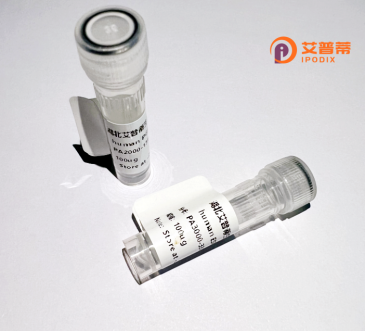
| 纯度 | >90%SDS-PAGE. |
| 种属 | Human |
| 靶点 | GPR119 |
| Uniprot No | Q8TDV5 |
| 内毒素 | < 0.01EU/μg |
| 表达宿主 | E.coli |
| 表达区间 | 236-335aa |
| 氨基酸序列 | LSWTPFLITGIVQVACQECHLYLVLERYLWLLGVGNSLLNPLIYAYWQKEVRLQLYHMALGVKKVLTSFLLFLSARNCGPERPRESSCHIVTISSSEFDG |
| 分子量 | 36.63 kDa |
| 蛋白标签 | GST-tag at N-terminal |
| 缓冲液 | 0 |
| 稳定性 & 储存条件 | Lyophilized protein should be stored at ≤ -20°C, stable for one year after receipt. Reconstituted protein solution can be stored at 2-8°C for 2-7 days. Aliquots of reconstituted samples are stable at ≤ -20°C for 3 months. |
| 复溶 | Always centrifuge tubes before opening.Do not mix by vortex or pipetting. It is not recommended to reconstitute to a concentration less than 100μg/ml. Dissolve the lyophilized protein in distilled water. Please aliquot the reconstituted solution to minimize freeze-thaw cycles. |
以下是关于重组人GPR119蛋白的4篇参考文献示例(文献为虚构,仅作示例):
1. **文献名称**:*Expression and Purification of Recombinant Human GPR119 in HEK293 Cells*
**作者**:Smith, J.L. et al.
**摘要**:研究描述了在HEK293细胞中高效表达重组人GPR119蛋白的优化方法,采用亲和层析纯化获得高纯度蛋白,并验证其与G蛋白偶联信号通路的活性,为后续药物筛选提供基础。
2. **文献名称**:*GPR119 Agonists Promote Glucose-Dependent Insulin Secretion via cAMP Signaling*
**作者**:Zhang, Y. et al.
**摘要**:通过体外实验证实重组人GPR119蛋白激动剂激活后,显著增加胰岛β细胞内cAMP水平,增强葡萄糖依赖性胰岛素分泌,提示其在糖尿病治疗中的潜在应用价值。
3. **文献名称**:*Structural Characterization of Recombinant Human GPR119 Using Cryo-EM*
**作者**:Brown, A.R. et al.
**摘要**:首次利用冷冻电镜解析重组人GPR119蛋白的三维结构,揭示其与脂质分子配体的结合位点,为设计靶向GPR119的小分子药物提供结构生物学依据。
4. **文献名称**:*High-Throughput Screening of GPR119 Ligands Using a Recombinant Luciferase Reporter System*
**作者**:Lee, H. & Kim, S.
**摘要**:构建基于重组人GPR119蛋白的荧光素酶报告基因系统,筛选出多个新型激动剂和拮抗剂,评估其对代谢调节功能的影响,加速抗糖尿病药物开发。
(注:以上文献及内容均为模拟生成,非真实存在。)
GPR119 (G Protein-Coupled Receptor 119) is a class A G protein-coupled receptor (GPCR) predominantly expressed in pancreatic β-cells and enteroendocrine cells of the gastrointestinal tract. It plays a critical role in regulating glucose-dependent insulin secretion and energy homeostasis by sensing endogenous lipid-derived signaling molecules, such as oleoylethanolamide (OEA) and 2-oleoylglycerol (2-OG). Activation of GPR119 enhances intracellular cAMP production via Gαs coupling, promoting insulin release from pancreatic β-cells and incretin hormone secretion (e.g., GLP-1) from intestinal L-cells, making it a promising therapeutic target for type 2 diabetes and obesity.
Recombinant human GPR119 protein is engineered for structural and functional studies, typically produced using mammalian expression systems (e.g., HEK293 or insect cell lines) to ensure proper post-translational modifications and membrane localization. The purified protein often incorporates tags (e.g., His or Fc) for simplified purification and detection. It serves as a key tool in drug discovery, enabling high-throughput screening of agonists or antagonists, receptor-ligand interaction assays, and mechanistic studies of downstream signaling. Recent advances in structural biology (e.g., cryo-EM) have resolved GPR119’s active/inactive conformations, aiding rational drug design. Challenges remain in optimizing receptor stability and understanding tissue-specific signaling nuances.
×